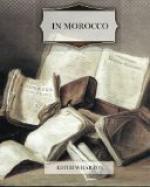What, then, prevents the tourist from instantly taking ship at Bordeaux or Algeciras and letting loose his motor on this new world? Only the temporary obstacles which the war has everywhere put in the way of travel. Till these are lifted it will hardly be possible to travel in Morocco except by favour of the Resident-General; but, normal conditions once restored, the country will be as accessible, from the straits of Gibraltar to the Great Atlas, as Algeria or Tunisia.
To see Morocco during the war was therefore to see it in the last phase of its curiously abrupt transition from remoteness and danger to security and accessibility; at a moment when its aspect and its customs were still almost unaffected by European influences, and when the “Christian” might taste the transient joy of wandering unmolested in cities of ancient mystery and hostility, whose inhabitants seemed hardly aware of his intrusion.
II
THE TRAIL TO EL-KSAR
With such opportunities ahead it was impossible, that brilliant morning of September, 1917, not to be off quickly from Tangier, impossible to do justice to the pale-blue town piled up within brown walls against the thickly-foliaged gardens of “the Mountain,” to the animation of its market-place and the secret beauties of its steep Arab streets. For Tangier swarms with people in European clothes, there are English, French and Spanish signs above its shops, and cab-stands in its squares; it belongs, as much as Algiers, to the familiar dog-eared world of travel—and there, beyond the last dip of “the Mountain,” lies the world of mystery, with the rosy dawn just breaking over it. The motor is at the door and we are off.
The so-called Spanish zone, which encloses internationalized Tangier in a wide circuit of territory, extends southward for a distance of about a hundred and fifteen kilometres. Consequently, when good roads traverse it, French Morocco will be reached in less than two hours by motor-travellers bound for the south. But for the present Spanish enterprise dies out after a few miles of macadam (as it does even between Madrid and Toledo), and the tourist is committed to the piste. These pistes—the old caravan-trails from the south—are more available to motors in Morocco than in southern Algeria and Tunisia, since they run mostly over soil which, though sandy in part, is bound together by a tough dwarf vegetation, and not over pure desert sand. This, however, is the utmost that can be said of the Spanish pistes. In the French protectorate constant efforts are made to keep the trails fit for wheeled traffic, but Spain shows no sense of a corresponding obligation.
After leaving the macadamized road which runs south from Tangier one seems to have embarked on a petrified ocean in a boat hardly equal to the adventure. Then, as one leaps and plunges over humps and ruts, down sheer banks into rivers, and up precipices into sand-pits, one gradually gains faith in one’s conveyance and in one’s spinal column; but both must be sound in every joint to resist the strain of the long miles to Arbaoua, the frontier post of the French protectorate.




